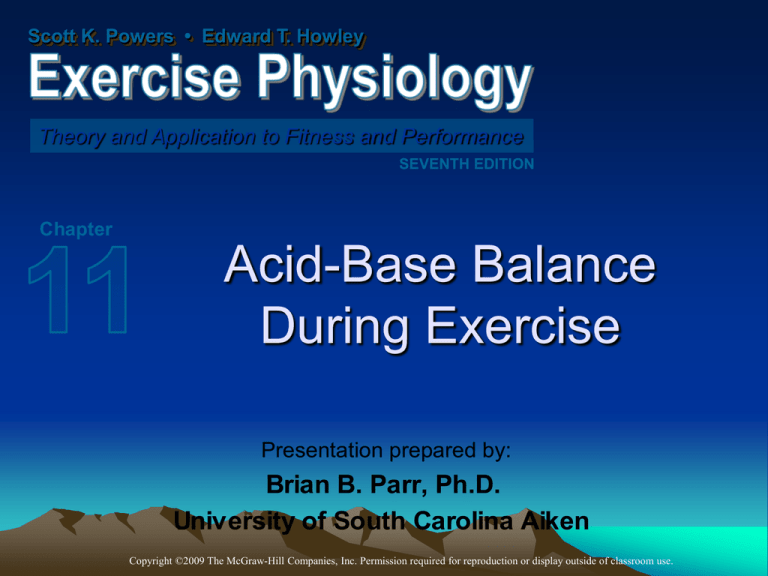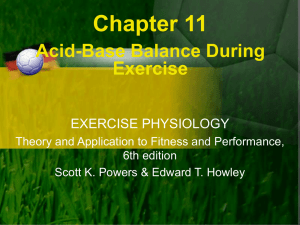
Scott K. Powers • Edward T. Howley
Theory and Application to Fitness and Performance
SEVENTH EDITION
Chapter
Acid-Base Balance
During Exercise
Presentation prepared by:
Brian B. Parr, Ph.D.
University of South Carolina Aiken
Copyright ©2009 The McGraw-Hill Companies, Inc. Permission required for reproduction or display outside of classroom use.
Chapter 11
Objectives
1. Define the terms acid, base, and pH.
2. Discuss the importance of acid-base
regulation to exercise performance.
3. List principal intracellular and extracellular
buffers.
4. Explain the role of respiration in the
regulation of acid-base status during
exercise.
5. Outline acid-base regulation during
exercise.
Copyright ©2009 The McGraw-Hill Companies, Inc. All Rights Reserved.
Chapter 11
Outline
Acids, Bases, and Acid-Base Buffer Regulation of
Acid-Base
Systems
pH
Balance via the
Intracellular Buffers
Hydrogen Ion
Extracellular Buffers
Kidneys
Production During Respiratory
Regulation of
Exercise
Influence on AcidAcid-Base
Base Balance
Importance of
Balance During
Exercise
Acid-Base
Regulation During
Exercise
Copyright ©2009 The McGraw-Hill Companies, Inc. All Rights Reserved.
Chapter 11
Acids, Bases, and pH
Acids and Bases
• Acid
– Molecule that can liberate H+
• Increases H+ concentration in solution
– Lactic acid is a strong acid
• Base
– Molecule that is capable of combining with H+
– Bicarbonate (HCO3–) is a strong base
Copyright ©2009 The McGraw-Hill Companies, Inc. All Rights Reserved.
Chapter 11
Acids, Bases, and pH
pH
• Expression of H+ solution in solution
• Negative logarithm of H+ concentration
pH = –log10[H+]
pH of pure water
pH (pure water) = –log10[H+] = 7.0
Copyright ©2009 The McGraw-Hill Companies, Inc. All Rights Reserved.
Chapter 11
Acids, Bases, and pH
pH of Blood
• Normal
pH = 7.4±0.05
• Acidosis
pH < 7.4
• Alkalosis
pH > 7.4
• Abnormal pH can disrupt normal body
function and affect performance
Survival range: 6.8–7.8
Copyright ©2009 The McGraw-Hill Companies, Inc. All Rights Reserved.
Chapter 11
Acids, Bases, and pH
The pH Scale
Copyright ©2009 The McGraw-Hill Companies, Inc. All Rights Reserved.
Figure 11.1
Chapter 11
Acids, Bases, and pH
Acidosis and Alkalosis
Copyright ©2009 The McGraw-Hill Companies, Inc. All Rights Reserved.
Figure 11.2
Chapter 11
Clinical Applications 11.1
Acids, Bases, and pH
Conditions and Diseases That
Promote Metabolic Acidosis or
• Metabolic acidosis
Alkalosis
– Gain in the amount of acid in the body
– Long-term starvation
• Through production of ketoacids
• From fat metabolism
– Uncontrolled diabetes
• Diabetic ketoacidosis
• Metabolic alkalosis
– Loss of acids from the body
– Severe vomiting
– Kidney disease
Copyright ©2009 The McGraw-Hill Companies, Inc. All Rights Reserved.
Chapter 11
Acids, Bases, and pH
In Summary
Acids are defined as molecules that can
liberate hydrogen ions, which increases
the hydrogen ion concentration of an
aqueous solution.
Bases are molecules that are capable of
combining with hydrogen ions.
The concentration of hydrogen ions in
a solution is quantified by pH units. The
pH of a solution is defined as the
negative logarithm of the hydrogen ion
Copyright ©2009 The McGraw-Hill Companies, Inc. All Rights Reserved.
Chapter 11
Hydrogen Ion Production During Exercise
+
H
Sources of
Ions During
Exercise
• Volatile acids
– Carbon dioxide
• End product of carbohydrate, fat, and protein
+ + HCO –
CO
+
H
O
H
CO
H
metabolism
2
2
2
3
3
• Fixed acids
– Sulfuric acid
• From metabolism of certain amino acids
– Phosphoric acid
• From phospholipid and nucleic acid metabolism
Copyright ©2009 The McGraw-Hill Companies, Inc. All Rights Reserved.
Chapter 11
Hydrogen Ion Production During Exercise
Sources of Hydrogen Ions Due
to Metabolic Processes
Copyright ©2009 The McGraw-Hill Companies, Inc. All Rights Reserved.
Figure 11.3
Chapter 11
Hydrogen Ion Production During Exercise
Popular Sports and Acid-Base
Balance
Copyright ©2009 The McGraw-Hill Companies, Inc. All Rights Reserved.
Chapter 11
A CloserHydrogen
LookIon11.1
Production During Exercise
Sport and Exercise-Induced
Disturbances in Muscle Acid-Base
Balance
• Sports lasting ≥45
seconds can produce
significant amounts of H+
• In many sports, risk of acid-base balance
is related to effort of the competitor
– Playing at 100% increases risk
– Sprint to finish in distance event increases
risk
• Acid-base disturbances can limit
performance
– Contributes to fatigue
Copyright ©2009 The McGraw-Hill Companies, Inc. All Rights Reserved.
Chapter 11
Hydrogen Ion Production During Exercise
In Summary
Metabolic acids can be subdivided into
three major groups: (1) volatile acids
(e.g., carbon dioxide), (2) fixed acids
(e.g., sulfuric acid, phosphoric acid),
and (3) organic acids (e.g., lactic acid).
Copyright ©2009 The McGraw-Hill Companies, Inc. All Rights Reserved.
Chapter 11
Importance of Acid-Base Regulation During Exercise
Importance of Acid-Base
Regulation During Exercise
• Heavy exercise results in production of
lactic acid
• Increased [H+] can impair performance
– Inhibits enzymes in aerobic and anaerobic
ATP production
– Hinders muscle contractile process by
competing with Ca+2 for binding sites on
troponin
Copyright ©2009 The McGraw-Hill Companies, Inc. All Rights Reserved.
Chapter 11
Importance of Acid-Base Regulation During Exercise
In Summary
Failure to maintain acid-base balance
may impair performance by inhibiting
metabolic pathways for the production
of ATP or by interfering with the
contractile process in the working
muscle.
Copyright ©2009 The McGraw-Hill Companies, Inc. All Rights Reserved.
Chapter 11
Acid-Base Buffer Systems
Acid-Base Buffer Systems
• Acid-base balance maintained by buffers
– Release H+ ions when pH is high
– Accept H+ ions when pH is low
• Intracellular buffers
– Proteins
– Phosphate groups
– Bicarbonate
• Extracellular buffers
– Bicarbonate
– Hemoglobin
Copyright ©2009 The McGraw-Hill Companies, Inc. All Rights Reserved.
Chapter 11
Acid-Base Buffer Systems
Bicarbonate Buffering System
• Bicarbonate buffering system
CO2 + H2O H2CO3 H+ + HCO3–
• Henderson-Hasselbalch equation
– Describes ability of bicarbonate-carbonic acid
to
as buffer
pHact
= pKa
+ log10system
(HCO3– / H2CO3)
Copyright ©2009 The McGraw-Hill Companies, Inc. All Rights Reserved.
Chapter 11
Acid-Base Buffer Systems
Acid-Base Buffer Systems
Copyright ©2009 The McGraw-Hill Companies, Inc. All Rights Reserved.
Chapter 11
Acid-Base Buffer Systems
The Winning Edge 11.1
Ingestion of Sodium Buffers and
Human Performance
• Some studies show improved
performance with ingestion of sodium
buffers
– Other studies show no improvement in
performance
• Sodium Buffers
– Sodium bicarbonate and sodium citrate
– Can increase time to exhaustion during highintensity exercise (80–120% VO2 max)
• Considerations for use
Copyright ©2009 The McGraw-Hill Companies, Inc. All Rights Reserved.
Chapter 11
Acid-Base Buffer Systems
In Summary
The body maintains acid-base
homeostasis by buffer-control systems.
A buffer resists pH change by removing
hydrogen ions when the pH declines
and by releasing hydrogen ions when
the pH increases.
The principal intracellular buffers are
proteins, phosphate groups, and
bicarbonate. Primary extracellular
buffers are bicarbonate, hemoglobin,
Copyright ©2009 The McGraw-Hill Companies, Inc. All Rights Reserved.
Chapter 11
Respiratory Influence on Acid-Base Balance
Respiratory Influence on AcidBase Balance
• Carbonic acid dissociation equation
CO2 + H2O H2CO3 H+ + HCO3–
• When pH decreases, [H+] increases
– Reaction moves to the left
– CO2 is “blown off” by the lungs, raising pH
Copyright ©2009 The McGraw-Hill Companies, Inc. All Rights Reserved.
Chapter 11
Respiratory Influence on Acid-Base Balance
In Summary
Respiratory control of acid-base
balance involves
the regulation on blood PCO2. An
increase in blood PCO2 lowers pH,
whereas a decrease in blood PCO2
increases pH.
Copyright ©2009 The McGraw-Hill Companies, Inc. All Rights Reserved.
Chapter 11
Regulation
of Acid-Base
Regulation
of Acid-Base Balance via the Kidneys
Balance via
the Kidneys
• Important in long-term acid-base balance
– Not significant in acid-base balance during
exercise
• Regulate blood bicarbonate concentration
– When blood pH decreases
• Reduced rate of bicarbonate excretion
– When blood pH increases
• Increased rate of bicarbonate excretion
Copyright ©2009 The McGraw-Hill Companies, Inc. All Rights Reserved.
Chapter 11
Regulation of Acid-Base Balance via the Kidneys
In Summary
Although the kidneys play an important
role in the long-term regulation of acidbase balance, the kidneys are not
significant in the regulation of acidbase balance during exercise.
Copyright ©2009 The McGraw-Hill Companies, Inc. All Rights Reserved.
Chapter 11
Regulation of Acid-Base Balance During Exercise
Regulation of Acid-Base
Balance During Exercise
• Lactic acid production depends on:
– Exercise intensity
– Amount of muscle mass involved
– Duration of exercise
• Blood pH
– Declines with increasing intensity exercise
• Muscle pH
– Declines more dramatically than blood pH
• Muscle has lower buffering capacity
Copyright ©2009 The McGraw-Hill Companies, Inc. All Rights Reserved.
Chapter 11
Regulation of Acid-Base Balance During Exercise
Changes in Arterial Blood and
Muscle pH During Exercise
Copyright ©2009 The McGraw-Hill Companies, Inc. All Rights Reserved.
Figure 11.4
Chapter 11
Regulation
of ofAcid-Base
Regulation
Acid-Base Balance During Exercise
Balance
During Exercise
• Buffering of lactic acid in the muscle
– 60% through intracellular proteins
– 20–30% by muscle bicarbonate
– 10–20% from intracellular phosphate
groups
• Buffering of lactic acid in the blood
– Bicarbonate is major buffer
• Increases in lactic acid accompanied by
decreases in bicarbonate and blood pH
– Hemoglobin and blood proteins play minor
role
Copyright ©2009 The McGraw-Hill Companies, Inc. All Rights Reserved.
Chapter 11
Regulation of Acid-Base Balance During Exercise
Changes in Blood Lactic Acid,
HCO3–, and pH During Exercise
Copyright ©2009 The McGraw-Hill Companies, Inc. All Rights Reserved.
Figure 11.5
Chapter 11
Regulation
of ofAcid-Base
Regulation
Acid-Base Balance During Exercise
Balance
During Exercise
• First line
– Cellular buffers
• Proteins, bicarbonate, and phosphate groups
– Blood buffers
• Bicarbonate, hemoglobin, and proteins
• Second line
– Respiratory compensation
• Increased ventilation in response to increased H+
concentration
Copyright ©2009 The McGraw-Hill Companies, Inc. All Rights Reserved.
Lines of Defense
Against
pHExercise
Regulation of Acid-Base
Balance During
Change During Intense
Exercise
Chapter 11
Copyright ©2009 The McGraw-Hill Companies, Inc. All Rights Reserved.
Figure 11.6
Chapter 11
Regulation of Acid-Base Balance During Exercise
In Summary
Figure 11.6 outlines the process of
buffering exercise-induced acidosis.
The first line of defense against
exercise-produced hydrogen ions is the
chemical buffer systems of the
intracellular compartment and the
blood. These buffer systems act rapidly
to convert strong acids into weak acids.
Intracellular buffering occurs with the
aid of cellular proteins, bicarbonate,
Copyright ©2009 The McGraw-Hill Companies, Inc. All Rights Reserved.
Chapter 11
Regulation of Acid-Base Balance During Exercise
In Summary
Blood buffering of hydrogen ions
occurs through bicarbonate,
hemoglobin, and blood proteins, with
bicarbonate playing the most important
role.
The second line of defense against pH
shift during exercise is respiratory
compensation for metabolic acidosis.
Copyright ©2009 The McGraw-Hill Companies, Inc. All Rights Reserved.
Chapter 11
Study Questions
1. Define the terms acid, base, buffer, acidosis,
alkalosis, and pH.
2. Graph the pH scale. Label the pH values that
represent normal arterial and intracellular pH.
3. List and briefly describe the major groups of
acids formed by the body.
4. Why is the maintenance of acid-base
homeostasis important to physical
performance?
5. What are the principal intracellular and
extracellular buffers?
Copyright ©2009 The McGraw-Hill Companies, Inc. All Rights Reserved.










